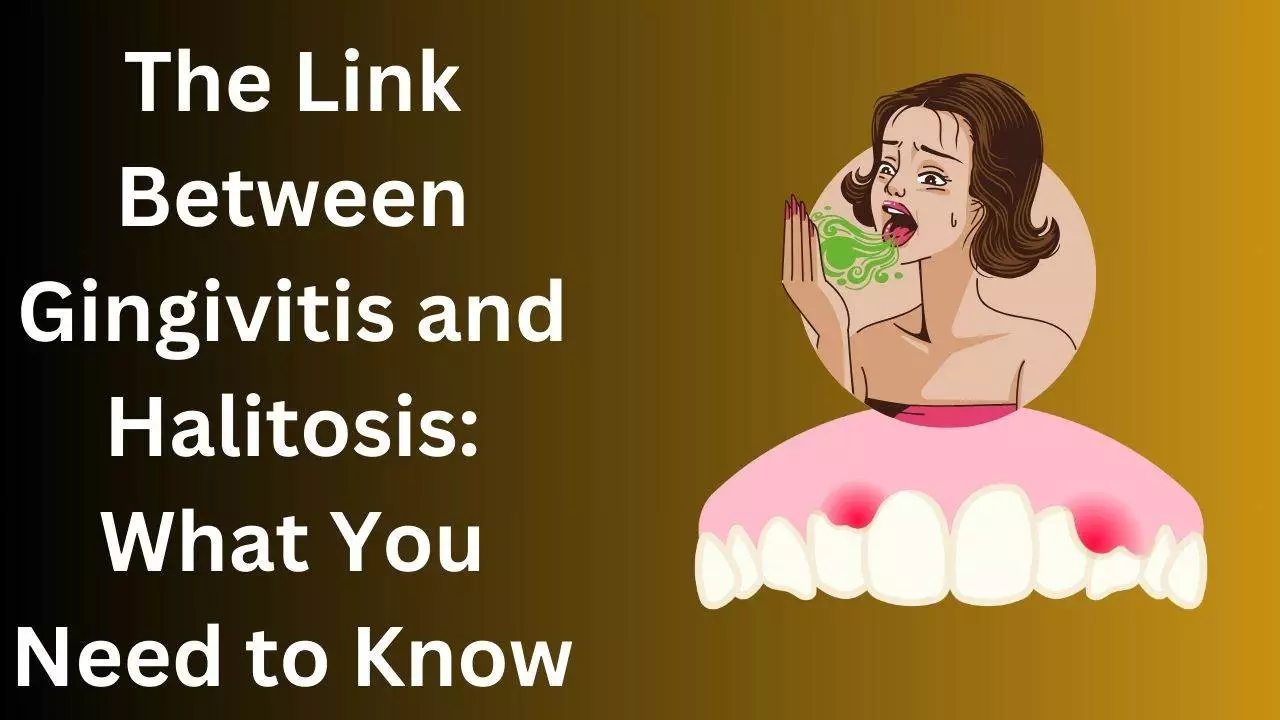
- What is Gingivitis and How Does it Develop?
- What is Halitosis and How Does it Develop?
- The Connection Between Gingivitis and Halitosis
- How Gingivitis Causes Halitosis: The Science Behind it
- Signs and Symptoms of Gingivitis and Halitosis
- Risk Factors for Gingivitis and Halitosis: Who is Most at Risk?
- Prevention of Gingivitis and Halitosis: Tips and Strategies
- Treatment Options for Gingivitis and Halitosis
- The Importance of Good Oral Hygiene in Preventing Gingivitis and Halitosis
- Taking Control of Your Oral Health to Prevent Gingivitis and Halitosis
Gingivitis and halitosis are two common oral health conditions that can have a significant impact on a person’s overall well-being. Gingivitis is a mild form of gum disease that causes inflammation and irritation of the gums. It is often characterized by red, swollen gums that may bleed easily. Halitosis, on the other hand, is the medical term for bad breath. It can be caused by a variety of factors, including poor oral hygiene, certain foods, and underlying health conditions.
Maintaining good oral health is essential for overall health and well-being. Poor oral hygiene can lead to a variety of oral health problems, including gum disease and bad breath. It is important to understand the basics of gingivitis and halitosis in order to prevent and treat these conditions effectively.
What is Gingivitis and How Does it Develop?
Gingivitis is a common form of gum disease that occurs when plaque, a sticky film of bacteria, builds up on the teeth and gums. Plaque contains harmful bacteria that can irritate the gums and cause inflammation. If left untreated, gingivitis can progress to a more severe form of gum disease called periodontitis.
There are several factors that can contribute to the development of gingivitis. Poor oral hygiene is one of the main causes, as it allows plaque to build up on the teeth and gums. Other factors that can increase the risk of developing gingivitis include smoking, hormonal changes (such as during pregnancy or menopause), certain medications, and certain medical conditions (such as diabetes).
Gingivitis typically develops in stages. In the early stage, known as gingivitis, the gums may become red, swollen, and tender. They may also bleed easily when brushing or flossing. If left untreated, gingivitis can progress to periodontitis, which is a more severe form of gum disease that can cause irreversible damage to the gums and bone that support the teeth.
What is Halitosis and How Does it Develop?
Halitosis, or bad breath, is a common condition that can be embarrassing and socially isolating. It is often caused by poor oral hygiene, as bacteria in the mouth can produce foul-smelling gases. However, there are also other factors that can contribute to the development of halitosis.
Halitosis can be caused by a variety of factors, including certain foods (such as garlic or onions), poor oral hygiene, dry mouth, smoking, certain medical conditions (such as sinus infections or gastrointestinal disorders), and certain medications. In some cases, halitosis may be a sign of an underlying health problem that requires medical attention.
There are different types of halitosis, including transient halitosis and chronic halitosis. Transient halitosis is temporary and usually occurs after eating certain foods or as a result of poor oral hygiene. Chronic halitosis, on the other hand, is persistent and may require medical intervention to treat.
The Connection Between Gingivitis and Halitosis
Gingivitis and halitosis are closely related conditions. In fact, gingivitis is one of the main causes of halitosis. When the gums become inflamed and infected due to gingivitis, bacteria can multiply and produce foul-smelling gases that contribute to bad breath.
The connection between gingivitis and halitosis lies in the role of bacteria in both conditions. Bacteria in the mouth can produce sulfur compounds that have a strong odor. When plaque builds up on the teeth and gums due to poor oral hygiene, bacteria can thrive and produce these foul-smelling gases. This can lead to both gingivitis and halitosis.
How Gingivitis Causes Halitosis: The Science Behind it
The science behind the connection between gingivitis and halitosis lies in the role of bacteria in both conditions. When the gums become inflamed and infected due to gingivitis, bacteria can multiply and produce foul-smelling gases. These gases can then be released into the mouth, causing bad breath.
Bacteria in the mouth feed on food particles and produce waste products. These waste products can include sulfur compounds, which have a strong odor. When plaque builds up on the teeth and gums, bacteria can thrive and produce more of these sulfur compounds. This can lead to both gingivitis and halitosis.
In addition to bacteria, other factors can also contribute to bad breath in people with gingivitis. For example, the inflammation and infection of the gums can cause an increase in saliva production. This excess saliva can mix with bacteria and food particles in the mouth, creating an environment that is conducive to bad breath.
Signs and Symptoms of Gingivitis and Halitosis
Gingivitis and halitosis have distinct signs and symptoms that can help identify these conditions.
Common signs and symptoms of gingivitis include:
– Red, swollen gums
– Tender or bleeding gums
– Receding gums
– Persistent bad breath
– Loose teeth
– Changes in bite or tooth alignment
Common signs and symptoms of halitosis include:
– Persistent bad breath
– A sour or metallic taste in the mouth
– Dry mouth
– White or yellow coating on the tongue
– Thick saliva
– Post-nasal drip
It is important to note that not everyone with gingivitis will experience bad breath, and not everyone with bad breath will have gingivitis. However, there is a strong correlation between the two conditions, and addressing gingivitis can often help improve bad breath.
Risk Factors for Gingivitis and Halitosis: Who is Most at Risk?
There are several risk factors that can increase the likelihood of developing gingivitis and halitosis.
Factors that increase the risk of developing gingivitis include:
– Poor oral hygiene
– Smoking or tobacco use
– Hormonal changes (such as during pregnancy or menopause)
– Certain medications (such as anticonvulsants or immunosuppressants)
– Certain medical conditions (such as diabetes or HIV/AIDS)
Factors that increase the risk of developing halitosis include:
– Poor oral hygiene
– Dry mouth
– Smoking or tobacco use
– Certain foods (such as garlic or onions)
– Certain medical conditions (such as sinus infections or gastrointestinal disorders)
– Certain medications (such as antihistamines or antidepressants)
It is important to note that while these risk factors can increase the likelihood of developing gingivitis and halitosis, anyone can develop these conditions. Therefore, it is important for everyone to practice good oral hygiene and seek regular dental care to prevent and treat these conditions.
Prevention of Gingivitis and Halitosis: Tips and Strategies
Preventing gingivitis and halitosis requires a combination of good oral hygiene practices and lifestyle changes. Here are some tips and strategies for preventing these conditions:
Tips for preventing gingivitis:
1. Brush your teeth twice a day with a soft-bristled toothbrush and fluoride toothpaste.
2. Floss daily to remove plaque and food particles from between the teeth.
3. Use an antimicrobial mouthwash to kill bacteria in the mouth.
4. Avoid smoking or using tobacco products.
5. Eat a balanced diet that is rich in fruits, vegetables, and whole grains.
6. Limit your intake of sugary foods and drinks.
7. Visit your dentist regularly for check-ups and professional cleanings.
Strategies for preventing halitosis:
1. Practice good oral hygiene by brushing your teeth twice a day, flossing daily, and using an antimicrobial mouthwash.
2. Drink plenty of water to keep your mouth hydrated and wash away bacteria and food particles.
3. Avoid foods that can cause bad breath, such as garlic or onions.
4. Quit smoking or using tobacco products.
5. Treat underlying medical conditions that may be contributing to bad breath.
6. Visit your dentist regularly for check-ups and professional cleanings.
By following these tips and strategies, you can significantly reduce your risk of developing gingivitis and halitosis.
Treatment Options for Gingivitis and Halitosis
There are several treatment options available for gingivitis and halitosis, depending on the severity of the condition.
Treatment options for gingivitis include:
– Improved oral hygiene practices, such as brushing and flossing regularly
– Professional dental cleanings to remove plaque and tartar
– Scaling and root planing, a deep cleaning procedure that removes plaque and tartar from below the gumline
– Antibacterial mouthwashes or gels to kill bacteria in the mouth
– Medications or antibiotics to reduce inflammation and infection
Treatment options for halitosis include:
– Improved oral hygiene practices, such as brushing and flossing regularly
– Professional dental cleanings to remove plaque and tartar
– Treatment of underlying medical conditions that may be causing bad breath
– Use of antimicrobial mouthwashes or gels to kill bacteria in the mouth
– Use of saliva substitutes or medications to treat dry mouth
– Dietary changes to avoid foods that can cause bad breath
It is important to consult with a dentist or healthcare professional for an accurate diagnosis and appropriate treatment plan for gingivitis or halitosis.
The Importance of Good Oral Hygiene in Preventing Gingivitis and Halitosis
Maintaining good oral hygiene is crucial for preventing both gingivitis and halitosis. Good oral hygiene practices can help remove plaque and bacteria from the teeth and gums, reducing the risk of inflammation, infection, and bad breath.
Brushing your teeth twice a day with a soft-bristled toothbrush and fluoride toothpaste is one of the most important aspects of good oral hygiene. It helps remove plaque and food particles from the teeth and gums, preventing the buildup of bacteria. Flossing daily is also essential for removing plaque and food particles from between the teeth, where a toothbrush cannot reach.
In addition to brushing and flossing, using an antimicrobial mouthwash can help kill bacteria in the mouth and freshen breath. It is also important to visit your dentist regularly for check-ups and professional cleanings. A dentist can remove plaque and tartar that cannot be removed by brushing and flossing alone, as well as identify any signs of gingivitis or halitosis.
Maintaining good oral hygiene is not only important for preventing gingivitis and halitosis but also for overall health. Poor oral health has been linked to a variety of systemic health conditions, including heart disease, diabetes, and respiratory infections. Therefore, taking care of your oral health should be a priority for everyone.
Taking Control of Your Oral Health to Prevent Gingivitis and Halitosis
Gingivitis and halitosis are common oral health conditions that can have a significant impact on a person’s overall well-being. Understanding the basics of these conditions, including their causes, symptoms, and treatment options, is essential for preventing and treating them effectively.
Maintaining good oral hygiene practices, such as brushing and flossing regularly, using an antimicrobial mouthwash, and visiting your dentist regularly, is crucial for preventing both gingivitis and halitosis. By taking control of your oral health and practicing good oral hygiene, you can significantly reduce your risk of developing these conditions and improve your overall well-being.
Remember, prevention is always better than cure. By following the tips and strategies outlined in this article, you can take control of your oral health and prevent gingivitis and halitosis. Your smile and your breath will thank you!









